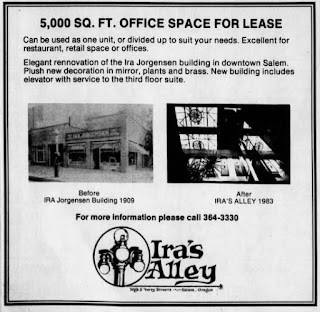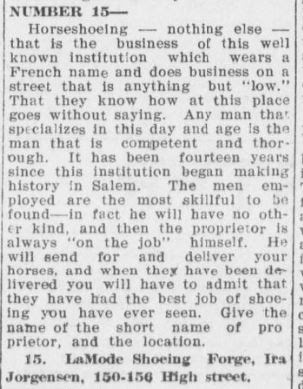(As with "Growl Movement," what is it with this toilet jokery, even with the appeal to "cowboy" nostalgia? Apparently it works, at least in North Dakota, as they've established a successful business there and are expanding here.)
 |
| June 5th, 1919 |
 |
| Advertising the renovation, September 23rd, 1983 (The "before" dating of 1909 is too early - see below) |
 |
| The building has a Ferry Street address |
This building, constructed c.1915, is associated with the life of Ira Jorgensen, a leader in Salem's early and developing automotive industry. Born in Cloud County, Kansas, in 1881, Ira Jorgensen came to Salem, Oregon, in 1891, with his parents, Peter and Minnie Jorgensen. Peter Jorgensen soon opened a wagon shop in Salem. Ira took up blacksmithing at a young age, and ventured into his own blacksmithing business in 1903 (after buying the blacksmith shop of John Holmes), which he continued until 1926....The trail of ads in the paper starts in 1905, when Jorgensen is associated with a fraternal organization.
 |
| December 19th, 1905 |
 |
| August 6th, 1906 |
 |
| Barrick Funeral Home historic postcard This is plausible for 1909, contra the 1983 ad (Salem Library Historic Photos) |
 |
| Corner of State and High with Cook's Hotel (match the dormers to those in the Barrick postcard) The horses and wagons are in front of the blacksmith shop circa 1900, could be before Jorgensen bought the shop, though (detail, via Oregon State Library) |
 |
| January 1, 1910 (Salem Hotel = Cook's) |
 |
| Answers on a downtown a scavenger hunt (September 8th, 1910) |
Again from the Historic District:
Five years earlier [than 1926], Jorgensen responded to the mounting ownership of automobiles in Salem (and across the country) by opening an automobile accessories (rims, springs, ties, etc.) business. Ira and his wife, Connie V. Lewis Jorgensen, a bookkeeper, bought the property at 535 Ferry Street in 1925. (At that time a two-story boarding house stood at that location, behind Jorgensen's existing auto repairing and mechanical shop on the corner of Ferry and High streets.) Ira Jorgensen continued to operate his automotive shop, fronting on High Street, through World War II.
 |
| April 11th, 1918 |
The Ira Jorgensen garage is one of several early downtown garage and auto businesses whose buildings have successfully been repurposed and are still standing. And indirectly it has ties to the earlier blacksmith business and the horse-and-buggy era.
The next wave of mid-century garage and car dealerships came with forms that have been less useful, and these seem sure to be demolished when the are finally redeveloped. (Like with the new Police Station!)


1 comment:
My grandfather comes from the tradition of men like Ira moving from being blacksmiths to auto mechanics and auto tires.
His father, James Chamberlain, was born around 1860 in the area south of Dallas to pioneer parents and became a blacksmith like his father. He later moved to Central Oregon at the request of his Uncle Frank Prine to a small settlement what later became Prineville. He worked as the city's main blacksmith. It was there in 1878 my grandfather was born and brought up in the family business to also be a blacksmith.
My grandfather, John Chamberlain, moved back to the Willamette Valley near Falls City as a young man. He continued to work in the area, but as transportation changed he moved on to work on all kinds of wheeled vehicles including early automobiles. My grandfather moved to Salem in 1920 with his young family and lived on North Street and worked at local auto repair shops until WWII. He moved to his maternal grandmother's property on the Lukiamute River in 1945 where he built a log cabin....even though no pioneer in the area actually ever lived in one as sawmills came to the area in the 1830s.
My point is that automobiles and blacksmiths are intricately linked in history.
Post a Comment